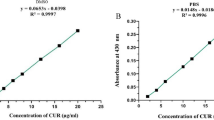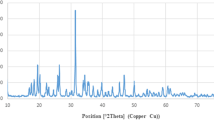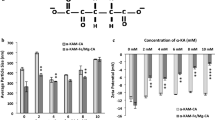Abstract
A new straightforward gel permeation chromatography (GPC) method was developed to calculate the drug encapsulation efficiency and loading content of Poly(lactic acid) nanoparticles (PLA NPs) loaded with Salinomycin (Sal), exploiting the capability of this technique to separate a macromolecular/molecular mixture on the basis of the molecular weight of each component. The proposed GPC method allowed Sal detection until 1% of Sal content in PLA NPs, avoiding sample pre-treatments. The method was validated by wave voltammetry (SW) technique, using a slightly modified literature procedure, useful to detect Sal in the concentration range 0.4 ≤ C/μmol/L ≤ 12 (linear concentration range). PLA-based NPs were prepared by nanoprecipitation with either native and functionalized PLA. Specifically, folate-decorated PLA NPs (PLA-FA NPs) were obtained by CuAAC click functionalization of alkyne-grafted PLA with azide-folate. Sal-loaded NPs were characterized physicochemically and morphologically. They exhibited adequate physicochemical properties, good drug encapsulation efficiency (98 ± 0.5% and 99 ± 0.5%), and loading content (8.8 ± 0.1% and 8.9 ± 0.1% for PLA/Sal and PLA-FA/Sal NPs, respectively). The size of empty PLA NPs resulted smaller (90 ± 3.2 nm and 680 ± 15.3 nm, for PLA NPs and PLA-FA NPs respectively) than the correspondent drug-loaded NPs (110 ± 3.8 nm and 875 ± 20.5 nm, respectively). Their biological activity was assessed on osteosarcoma bulk cells MG63, healthy osteoblast cell line (hFOB1.19), and enriched osteosarcoma cancer stem cells (CSCs), showing cell-depending effect. Entrapped Sal maintained its cytotoxic effect on CSCs and MG63 cells, with a potency comparable to the free drug and no evident benefit was detected for folate-decorated PLA NPs respect to native PLA NPs.

Graphical abstract









Similar content being viewed by others
References
Gupta PB, Onder TT, Jiang GZ, Tao K, Kuperwasser C, Weinberg RA, et al. Identification of selective inhibitors of cancer stem cells by high-throughput screening. Cell. 2009;138:645–9.
Kuşoğlu A, Biray AÇ. Cancer stem cells: a brief review of the current status. Gene. 2019;681:80–5.
Cancer Stem Cell Therapies Market, 2017-2030, 2017, ID 4457268
Dewangan J, Srivastava S, Rath SK. Salinomycin: a new paradigm in cancer therapy. Tumor Biol. 2017;39:1–12.
Naujokat C, Steinhart R. Salinomycin as a drug for targeting human cancer stem cells. J Biomed Biotechnol. 2012; Article ID 950658.
Fuchs D, Daniel V, Sadeghi M, Opelz G, Naujokat C. Salinomycin overcomes ABC transporter-mediated multidrug and apoptosis resistance in human leukemia stem cell-like KG-1a cells. Biochem Biophys Res Commun. 2010;394:1098–104.
Tang QL, Zhao ZQ, Li JC, Liang Y, Yin JQ, Zou CY, et al. Salinomycin inhibits osteosarcoma by targeting its tumor stem cells. Cancer Lett. 2011;311:113–21.
Lindsey BA, Markel JE, Kleinerman ES. Osteosarcoma overview. Rheumatol Ther. 2017;4:25–43.
Jaffe N. Recent advances in the chemotherapy of metastatic osteogenic sarcoma. Cancer. 1972;30:1627–31.
Durfee RA, Mohammed M, Luu HH. Review of osteosarcoma and current management. Rheumatol Ther. 2016;3:221–43.
Dai X, Ma W, He X, Jha RK. Review of therapeutic strategies for osteosarcoma, chondrosarcoma, and Ewing’s sarcoma. Med Sci Monit. 2011;17:RA177–90.
Piperno A, Marrazzo A, Scala A, Rescifina A. Chemistry and biology of salinomycin and its analogues. In: Attanasi OA, Merino P, Spinelli D, editors. Targets in heterocyclic systems, 19. Roma: Società Chimica Italiana; 2015. p. 177–213.
Nász S, Debreczeni L, Rikker T, Eke Z. Development and validation of a liquid chromatographic-tandem mass spectrometric method for determination of eleven coccidiostats in milk. Food Chem. 2012;133:536–43.
Rokka M, Jestoi M, Peltonen K. Trace level determination of polyether ionophores in feed. BioMed Res Int 2013;2013:Article ID 151363.
Pereira MU, Spisso BF, Jacob Sdo C, Monteiro MA, Ferreira RG, Carlos Bde S, et al. Validation of a liquid chromatography–electrospray ionization tandem mass spectrometric method to determine six polyether ionophores in raw, UHT, pasteurized and powdered milk. Food Chem. 2016;196:130–7.
Moloney M, Clarke L, O'Mahony J, Gadaj A, O'Kennedy R, Danaher M. Determination of 20 coccidiostats in egg and avian muscle tissue using ultra high performance liquid chromatography-tandem mass spectrometry. J Chromatogr A. 2012;1253:94–104.
Rudnicki K, Domagała S, Burnat B, Skrzypek S. Voltammetric and corrosion studies of the ionophoric antibiotic-salinomycin and its determination in a soil extract. J Electroanal Chem. 2016;783:56–62.
Zhou J, Sun J, Chen H, Peng Q. Promoted delivery of salinomycin sodium to lung cancer cells by dual targeting PLGA hybrid nanoparticles. Int J Oncol. 2018;53:1289–300.
Chen F, Zeng Y, Qi X, Chen Y, Ge Z, Jiang Z, et al. Targeted salinomycin delivery with EGFR and CD133 aptamers based dual-ligand lipidpolymer nanoparticles to both osteosarcoma cells and cancer stem cells. Nanomed Nanotechnol. 2018;14:2115–27.
Mi Y, Huang Y, Deng J. The enhanced delivery of salinomycin to CD133+ ovarian cancer stem cells through CD133 antibody conjugation with poly(lactic-co-glycolic acid)-poly(ethylene glycol) nanoparticles. Oncol Lett. 2018;15:6611–21.
Yu Z, Chen F, Qi X, Dong Y, Zhang Y, Ge Z, et al. Epidermal growth factor receptor aptamer-conjugated polymer-lipid hybrid nanoparticles enhance salinomycin delivery to osteosarcoma and cancer stem cells. Exp Ther Med. 2018;15:1247–56.
Daman Z, Faghihi H, Montazeri H. Salinomycin nanoparticles interfere with tumor cell growth and the tumor microenvironment in an orthotopic model of pancreatic cancer. Drug Dev Ind Pharm. 2018;44:1434–42.
Zhang Y, Zhang Q, Sun J, Liu H, Li Q. The combination therapy of salinomycin and gefitinib using poly(d,l-lactic-co-glycolic acid)-poly(ethylene glycol) nanoparticles for targeting both lung cancer stem cells and cancer cells. OncoTargets Ther. 2017;10:5653–66.
Aydın RST, Kaynak G, Gumusderelioglu M. Salinomycin encapsulated nanoparticles as a targeting vehicle for glioblastoma cells. J Biomed Mater Res A. 2016;104A:455–64.
Mathur AK. Determination of salinomycin by high-performance liquid chromatography using a precolumn derivatization technique. J Chromatogr A. 1994;664:284–8.
Wang Q, Wu P, Ren W, Xin K, Yang Y, Xie C, et al. Comparative studies of salinomycin-loaded nanoparticles prepared by nanoprecipitation and single emulsion method. Nanoscale Res Lett. 2014;9:351.
Muntimadugu E, Kumar R, Saladi S, Rafeeqi TA, Khan W. CD44 targeted chemotherapy for co-eradication of breast cancer stem cells and cancer cells using polymeric nanoparticles of salinomycin and paclitaxel. Colloids Surf B. 2016;143:532–46.
Fazio E, Scala A, Grimato S, Ridolfo A, Grassi G, Neri F. Laser light friggere smart release of silibinin from a PEGylated-PLGA gold nanocomposite. J Mater Chem B. 2015;3:9023–32.
Micale N, Piperno A, Mahfoudh N, Schurigt U, Schultheis M, Mineo PG, et al. A hyaluronic acid–pentamidine bioconjugate as a macrophage mediated drug targeting delivery system for the treatment of leishmaniasis. RSC Adv. 2015;5:95545–50.
Neri F, Scala A, Grimato S, Santoro M, Spadaro S, Barreca F, et al. Biocompatible silver nanoparticles embedded in a PEG-PLA polymeric matrix for stimulated laser light drug release. J Nanopart Res. 2016;18:153–68.
Spadaro S, Santoro M, Barreca F, Scala A, Grimato S, Neri F, et al. PEG-PLGA electrospun nanofibrous membranes loaded with Au@Fe2O3 nanoparticles for drug delivery applications. Front Phys. 2018;13:136201–9.
Scala A, Piperno A, Micale N, Mineo PG, Abbadessa A, Risoluti R, et al. “Click” on PLGA-PEG and hyaluronic acid:gaining access to anti-leishmanial pentamidine bioconjugates. J Biomed Mater Res Part B. 2018;106:2778–85.
Scala A, Piperno A, Torcasio SM, Nicosia A, Mineo PG, Grassi G. “Clickable” polylactic acids obtained by solvent free intra-chain amidation. Eur Polym J. 2018;109:341–6.
Piperno A, Zagami R, Cordaro A, Pennisi R, Musarra-Pizzo M, Scala A, et al. Exploring the entrapment of antiviral agents in hyaluronic acid-cyclodextrin conjugates. J Incl Phenom Macrocycl Chem. 2019;93:33–40.
You H, Fu S, Qin X, Yu Y, Yang B, Zhang G, et al. A study of the synergistic effect of folate-decorated polymeric micelles incorporating Hydroxycamptothecin with radiotherapy on xenografted human cervical carcinoma. Colloids Surf B: Biointerfaces. 2016;140:150–60.
Oh JH, Park DH, Joo JH, Lee JS. Recent advances in chemical functionalization of nanoparticles with biomolecules for analytical applications. Anal Bioanal Chem. 2015;407:8627–45.
Dorgan JR, Janzen J, Knauss DM, Hait SB, Limoge BR, Hutchinson MH. Fundamental solution and single-chain properties of polylactides. J Polym Sci B Polym Phys. 2005;43:3100–11.
Lienard R, Montesi M, Panseri S, Dozio SM, Vento F, Mineo PG, Piperno A, De Winter J, Coulembier O, Scala A. Design of naturally inspired jellyfish-shaped cyclo-polylactides to manage osteosarcoma cancer stem cells fate. Mat Sci Eng C, submitted.
Wang Y, Yao J, Meng H, Yu Z, Wang Z, Yuan X, et al. A novel long non-coding RNA, hypoxia-inducible factor-2α promoter upstream transcript, functions as an inhibitor of osteosarcoma stem cells in vitro. Mol Med Rep. 2015;11:2534–40.
Tirino V, Desiderio V, d'Aquino R, De Francesco F, Pirozzi G, Graziano A, et al. Detection and characterization of CD133+ cancer stem cells in human solid tumours. PLoS One. 2008;3:e3469.
Silva FRN, Bortolotte AR, Braga PA d C, Reyes FGR, Arisseto-Bragotto AP. Polyether ionophores residues in Minas Frescal cheese by UHPLC-MS/MS. Food Addit Contam Part B Surveill. 2020. https://doi.org/10.1080/19393210.2020.1739149.
Determination of eight coccidiostats in eggs by liquid–liquid extraction–solid-phase extraction and liquid chromatography–tandem mass spectrometry. Molecules 2020;25:987.
Kharbanda S, Hill J, Appajosyulan S, Rosenberg M, Singh H. Polymeric nanoparticles comprising salinomycin for treatment of cancer with reduced toxicity. Publication number: 20200046648.
Santos C, Gomes P, Duarte JA, Almeida MM, Costa ME, Fernandes MH. Development of hydroxyapatite nanoparticles loaded with folic acid to induce osteoblastic differentiation. Int J Pharm. 2017;516:185–95.
Martín-del-Campo M, Sampedro JG, Flores-Cedillo ML, Rosales-Ibañez R, Rojo L. Bone regeneration induced by strontium folate loaded biohybrid scaffolds. Molecules. 2019;24:E1660.
Liu Y, Xu C, Fan X, Loh XJ, Wu Y-L, Li Z. Preparation of mixed micelles carrying folates and stable radicals through PLA stereocomplexation for drug delivery. Mater Sci Eng C. 2020;108:110464.
Zagami R, Rapozzi V, Piperno A, Scala A, Triolo C, Trapani M, et al. Folate-decorated amphiphilic cyclodextrins as cell-targeted nanophototherapeutics. Biomacromolecules. 2019;20:2530–44.
Author information
Authors and Affiliations
Corresponding author
Ethics declarations
Conflict of interest
The authors declare that they have no competing interests.
Additional information
Publisher’s note
Springer Nature remains neutral with regard to jurisdictional claims in published maps and institutional affiliations.
Rights and permissions
About this article
Cite this article
Mineo, P.G., Foti, C., Vento, F. et al. Salinomycin-loaded PLA nanoparticles: drug quantification by GPC and wave voltammetry and biological studies on osteosarcoma cancer stem cells. Anal Bioanal Chem 412, 4681–4690 (2020). https://doi.org/10.1007/s00216-020-02721-6
Received:
Revised:
Accepted:
Published:
Issue Date:
DOI: https://doi.org/10.1007/s00216-020-02721-6




